The future of radio looks bright. Connecting radio with the Internet serves both the audience and advertiser, and turns radio into the world’s leading social audio network.
I received a kind email from Olga Smolyaninova, a Russian student of media management, who sent me a questionaire for her graduate work about The Future Of Radio Broadcasting Under The Conditions Of Technological Changes In Media Systems. Because it’s an interesting topic, here’s a summary of her questions and my answers regarding the future of radio.
The Internet will be an important distribution platform
and add-on for radio
1. How will the radiofrequency signal be transmitted in 2020 and why?
Radio broadcasting: multiple standards
From the perspective of terrestrial radio broadcasting, the implementation of digital radio varies from country to country. I’m writing this article in June 2012, when there are 4 main standards for terrestrial digital radio (DAB, DRM, IBOC, ISDB) that are being used worldwide. Some countries have already launched digital radio while others are still years behind, and this will affect the situation in 2020.
 Internet Protocol: single standard
Internet Protocol: single standard
IP (Internet Protocol) is a universal standard and is therefore suitable to be used worldwide, both stand-alone and in combination with terrestrial analog and digital radio broadcasting. It makes the Internet an important future distribution platform and add-on for radio, for a couple of reasons.
Internet radio distribution benefits
The Internet is a great distribution platform and addition to radio because it:
- is worldwide available
- offers cost-effective distribution
- holds an unlimited number of stations
- is popular on mobile devices, like smart phones and tablets
- is government-independent and censor-free (in most countries)
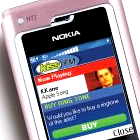 Wi-Fi coverage and cost
Wi-Fi coverage and cost
The only challenge is that overall Wi-Fi coverage is not present everywhere (yet) and that telecom operators (still) charge a lot for mobile data traffic. On the other side it’s a question of time before the prices drop, or a mastermind group of media inventors finds a smart new way to bring online radio to mobile devices for free (or for a lot less money).
RadioDNS is an exciting concept as it combines
radio broadcasting and Internet Protocol
2. What radio frequency transmission method will prevail and why?
Digital radio, several standards
Digital radio will prevail, probably through (a combination of) several different standards. When you buy an analog radio in Germany, the FM scale is titled UKW, but it’s the same technology. Bring this radio to Burundi, and you can listen to African FM stations. Whereas digital radio has several different standards; from DAB and DRM to the American IBOC (better known as HD Radio) and Japanese ISDB.
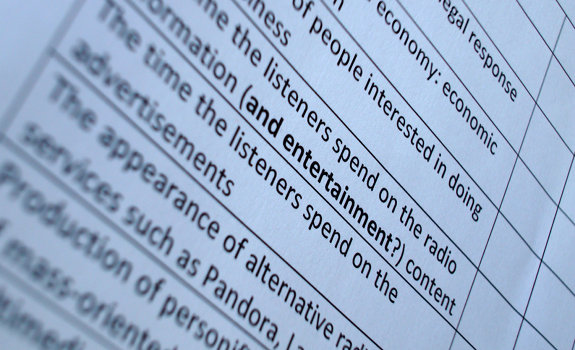
The future of radio is influenced by technological innovation, as well as audience behavior (photo: Thomas Giger)
Smart radio: hybrid receiver
It’s vital for the future of the international radio industry that manufacturers of consumer electronics offer low-priced ‘smart radios’, as I would like to call them. With these many different broadcast standards, the future of radio is a hybrid device – a receiver that’s not only suitable for (analog and) digital radio broadcasting, but can decode Internet Protocol as well.
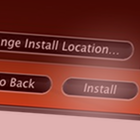 Software (not hardware) updates
Software (not hardware) updates
Smart radios should also be a piece of hardware that – just like a computer, laptop or smart phone – are fully upgraded through software. The benefit is of course that when a new broadcast standard emerges, you don’t need a new radio. Clicking the ‘Install’ button, like we’re used to with computer software, should be all it takes.
Radio and Internet combined
RadioDNS is an exciting concept as it combines radio broadcasting and Internet Protocol. DNS enhances radio broadcast standards (like DAB, HD, FM, and more) with images, video and data which come from the Internet. ‘Since it doesn’t need any changes to the transmission chain and uses existing Internet technology, it’s simple and cheap to implement’, so says The RadioDNS Project.
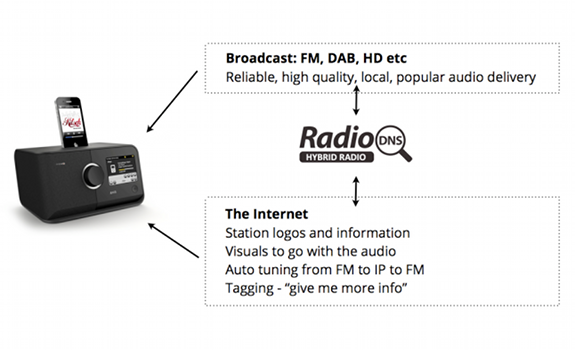
RadioDNS enhances audio with visuals by combining broadcast and Internet in one device (infographic: RadioDNS)
Long-term digital radio future
The challenge here is replacing all analog devices. The average citizen of Burundi might not be able to afford a smart radio yet, and consumers in ‘rich countries’ – although that’s very relative nowadays – need to replace all of their (many) analog receivers. It implies that, as Dutch media entrepreneur John de Mol says it, digital radio is a long-term niche business.
It takes time before analog radio is
completely replaced by digital broadcasting
3. What radio frequency transmission method existing today will not prevail, but will still be used in 2020?
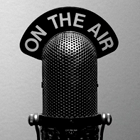 Analog radio eventually disappears
Analog radio eventually disappears
It is likely that analog transmission (such as AM and FM) will be exchanged by one (or more) digital equivalent(s). But it takes time before analog radio is completely replaced by digital broadcasting everywhere. And it currently doesn’t look like AM and FM will be off the map by 2020, at least not worldwide, for the reasons mentioned earlier.
Imagine what you can accomplish with a strong brand
and compelling content for a worldwide audience
4. What roles will Internet radio, terrestrial digital and analog broadcasting, cable and satellite broadcasting play in 2020?
Internet radio breaks boundaries
While analog and digital terrestrial distribution face a limited in capacity and reach, the Web can host millions of stations, broadcasting worldwide. Every radio station has the potential to reach billions (theoretically speaking, but fascinating). Imagine what you can accomplish with a strong brand and compelling content for a worldwide audience.
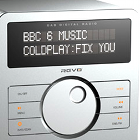 Digital radio timelines vary
Digital radio timelines vary
Terrestrial digital radio broadcasting will have replaced a part of the analog radio distribution by 2020, but not in every country. It depends on the local situation – on the government regulation, economic condition, radio industry, electronics industry, and of course on the consumer. A better audio quality alone won’t create enough need to buy digital radios. Content quality and format variety are much more important.
Cable radio remains indoors
With a trend that’s going towards mobile devices, I wonder what the future of cable is. I think that (optical fiber) cables could still be ideal for offices and homes – also to cut down our electromagnetic radiation exposure, but that’s another subject. Fiber is great for fast and high-quality distribution of radio and TV signals, landline phones and indoor-used Internet.
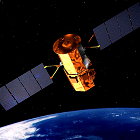 Satellite radio shows potential
Satellite radio shows potential
Satellite distribution sounds interesting, but requires a satellite receiver and a paid subscription for premium content. SiriusXM Radio has about 20 million subscribers (June 2012). This high absolute number becomes relatively small from a high altitude – 20 million people is about 6% of the US population. Satellite radio could grow, though; receivers are being installed in many new American cars.
Video-enriched and social-shared content helps to
keep radio ‘in the picture’ of a new generation of listeners
5. Do you agree with the statement that new technologies may enhance or radio instead of compete with it or distract listener’s attention from it?
Radio becomes visually social
New technologies can definitely improve radio’s service to the audience. Stations can enhance their auditive medium by adding visual radio and social radio. Video-enriched and social-shared content helps to keep radio ‘in the picture’ of a new generation of listeners – and this audience is attached to its mobile devices. Dutch CHR station 3FM does a nice job here:
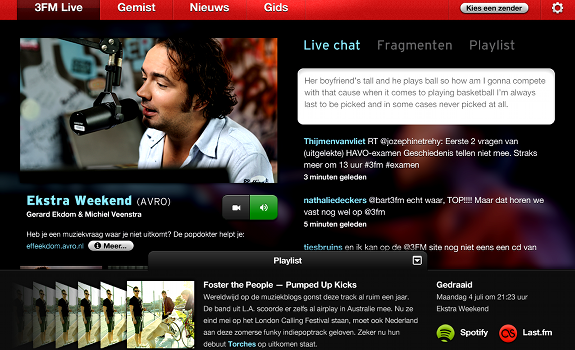
The social radio player of 3FM combines audio, video, images, text and social media into a larger and more interactive experience, appealing to a new generation of listeners who consume radio (also) online and mobile (design: 3FM)
Advertisers target listeners locally
Most free-to-air stations depend on advertisers, who will enjoy more value for money and return of investment. IP-based technologies – like integrating radio into an online platform – make it possible to add user & geographic targeting as well as conversion tracking to audio content. It provides a better service to sponsors.
‘Emotion is the heart of radio
that people will always love’
6. What will radio content be in 2020, and what role will the listener play?
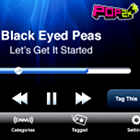 Radio cultivates crowd sourcing
Radio cultivates crowd sourcing
Radio will be the world’s social audio network, inviting the audience to share and create content. Stations already launch free apps that listeners use to record, edit, and submit audio, video and picture to the station, which it may use on-air and online. Mobile apps involve people in your radio station 24/7 – especially when you have a young audience you can create a mobile social community to interact and crowdsource.
Personalized radio is growing
The audience will have more choice than ever, as a huge amount of stations emerged through the unlimited capacity of IP-based channels. Strong brands and unique formats are highly important to be different and get noticed. It’s an opportunity to serve exactly defined audience demographics through personalized niche radio stations. The age of ‘My Radio’ is here.
 Radio’s power is emotion
Radio’s power is emotion
Production and distribution techniques have changed, but radio is still a friend that keeps you company. Engaging personalities tell interesting stories and offer a mix of information and entertainment. Radio has a unique selling proposition that Spotify & Co. cannot offer, and this X-factor of emotion is the heart of radio that people will always love. Radio stations should use technology to create an even stronger bond with the listener.
Read also:
Stay tuned, follow us @RadioILOVEIT and click below to share this post:





Add Your Comment